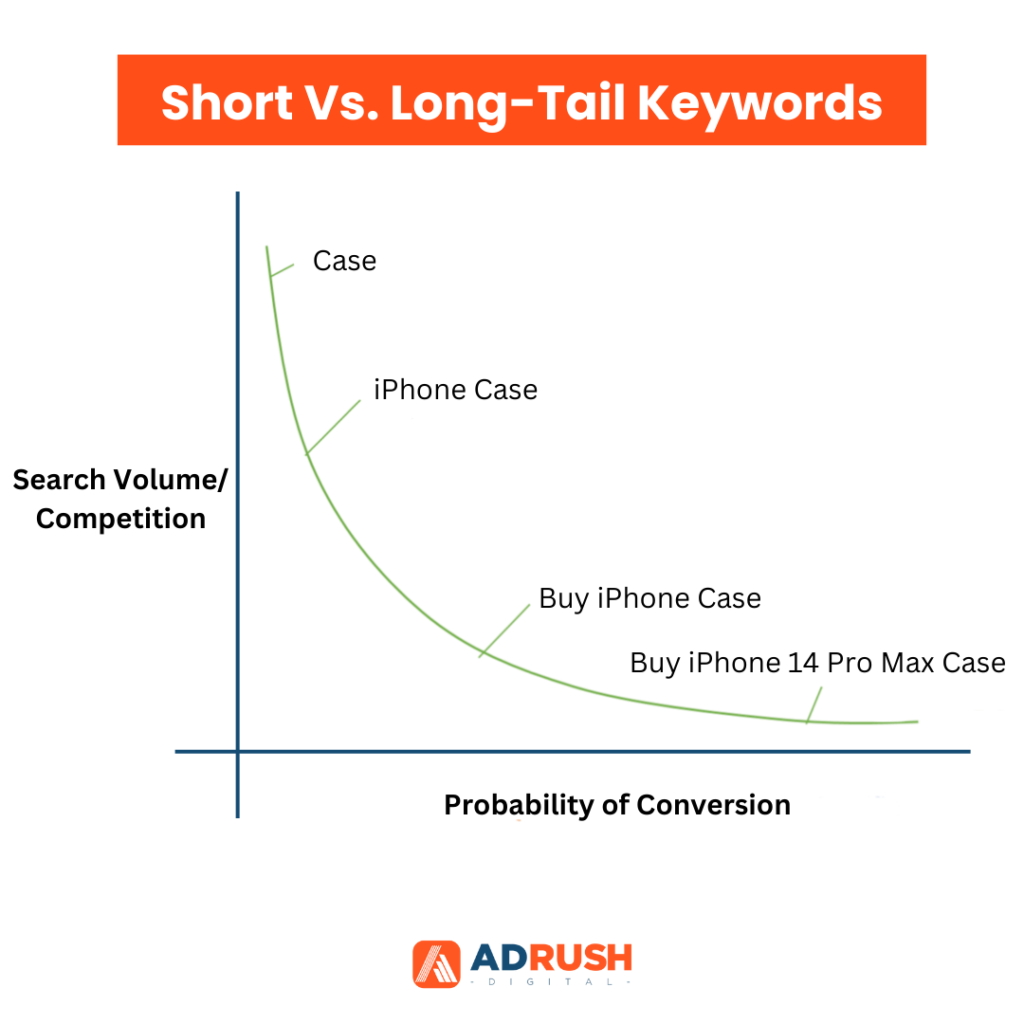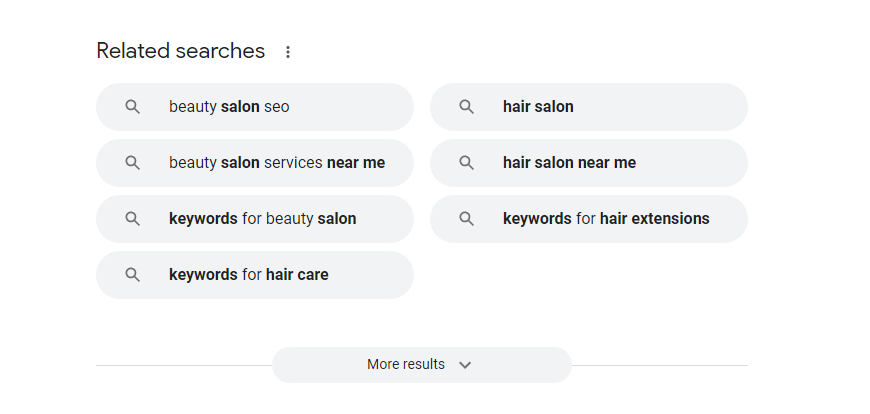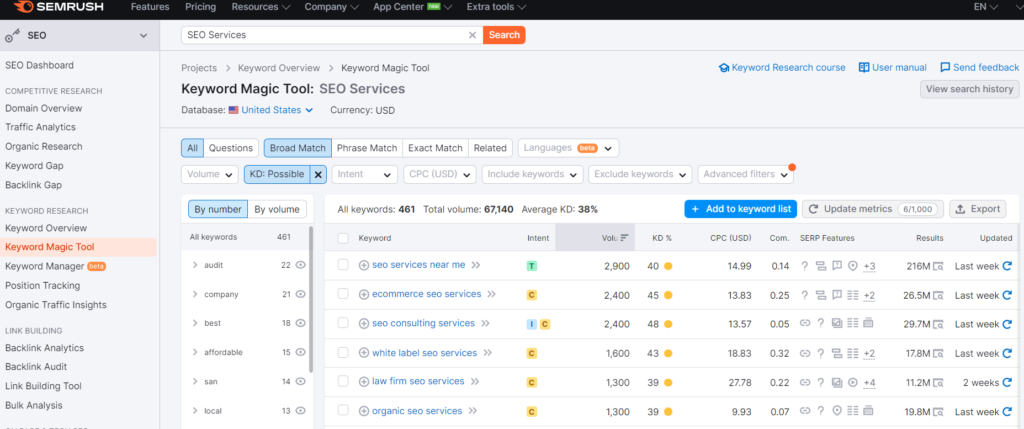SEO – Search Engine Optimization (SEO) is crucial for any successful digital marketing strategy. Even though there are methods to generate website traffic, such as social media and word-of-mouth marketing, SEO services still play a major role in driving organic online traffic. In fact, Google processes 8.5 billion searches every day. Among the many components of effective SEO, having the right Keyword Strategy is absolutely essential. When it comes to a keyword strategy, there are two types of keywords: short tail vs long tail keywords. In this article, we will discuss short tail vs long tail keywords and how you should use them to create a successful keyword strategy.
Short Tail Vs Long Tail Keywords: What’s the difference?
If you’ve just started learning SEO, you might have come across the phrases long tail vs short tail” keywords. Essentially, short tail keywords are brief and general phrases consisting of maximum 3 words, whereas long tail keywords are lengthier and more specific phrases, consisting of 4 or more words.
What Are Short Tail Keywords?
Short-tail keywords, also known as “broad keywords” or “head terms,” are general words or phrases that consist of 1-3 words and cover a wide topic. These keywords typically have a higher search volume compared to long-tail keywords, which means they attract more visitors but just because they bring in more visitors doesn’t necessarily mean they are high-quality keywords.
It’s because short-tail keywords often give generic search results that may not align with what exactly a user is looking for. This is because they are more commonly used, leading to less specific results.
Volume: High
When it comes to search volume, short tail keywords almost always outperform long tail keywords. The shorter the keyword, the higher the search volume tends to be. If you can successfully rank for a short-tail keyword, you can expect to receive a significant amount of organic traffic.
For example, if you search the term “SEO,” in the search engines, it will generate millions of results. It’s a short tail keyword, less specific and has millions of global monthly traffic. So if you’re thinking of getting your website ranked for this keyword…keep dreaming because it’s almost impossible.
Competition: High

The considerable search volumes associated with short-tail keywords make them high in demand, resulting in high competition. It is difficult to get ranked for these keywords.
Cost: High
Short-tail keywords can be expensive due to the cost associated with using Google AdWords to bid on them. Since many people are competing for these popular keywords, the demand drives up the cost, and you may need to pay a premium to ensure your visibility in these searches.
Conversion Rate: Low
As short-tail keywords cover broad topics, they usually have a very low conversion rate. Even if your website receives 10,000 searches and 100 clicks, it’s possible that you may only end up with one or two customers based on your conversion rate.
Long Tail Keywords:
By comparison, long-tail keywords are highly intentional search phrases than short tail keywords. They usually comprise 3 – 4 words and are much less popular as compared to short-tail keywords. They are different variations of short tail keywords.
Most search terms are actually long-tail keywords, with a staggering 92.42% of them having less than 10 searches per month. Therefore, it’s important to understand what long-tail keywords are and how to utilize them to optimize your website’s content.
Volume: Low
Long tail keywords have a low monthly search volume but they target a specific audience when you rank for them. These keywords bring less traffic but as the traffic is specific, they are more likely to convert. That’s why a lot of websites target long-tail keywords to get highly specific traffic.
For example, if you search “SEO Services For Beauty Salons,” it has a much low search volume as compared to “SEO.” It’s a long tail keyword, targets a more specific audience which might be interested in your services. If you target this keyword, there are high chances your website will rank for this keyword and pull more specific traffic ready to convert.
Competition: Low
As long-tail keywords have low search volume, they have low competition and that’s why such keywords are easy to rank.

Cost: Low
Using long-tail keywords with lower traffic has the advantage of being more cost-effective. Google AdWords offers reduced prices for specific searches that contain more terms, which means you may not rank as high in general searches initially (unless you establish a dominant presence in your industry), but the cost to achieve visibility will be significantly lower.
Conversion Rate: High
The best thing about long-tail keywords is that they have a high conversion rate. As the keywords target specific queries of the customers, the traffic they attract is more likely to convert into customers.
Example of Short Tail Vs Long Tail Keywords
If you sell iPhone cases, and you use the keywords “case” or “mobile phone case” both these keywords yield millions of results in SERPs and the term has thousands of monthly visitors. Needless to say, it’s impossible for websites, especially new websites to rank for such keywords in search results.

- Short Tail Keyword: iPhone Case
- Short Tail Keyword: Buy iPhone Case
- Long Tail Keyword: Buy iPhone 14 Pro Max Case
In the above example, we can see that the volume of long tail keyword decreases but the probability of the conversion rate increases. A user who searches “iPhone Case” is probably searching it for the the sake of getting information. However, a user who searches “Buy iPhone 14 Pro Max Case” is more likely to convert.
So, when creating a short tail vs long tail keywords strategy, it’s important to keep in mind that while long-tail keywords may result in lower website visits, they are more likely to yield specific results that align with your customers’ needs. This means that the traffic generated by long-tail keywords is more useful and more likely to convert visitors to your website.
How to Find Short Tail and Long Tail Keyword?
There are a number of ways you can find short vs long tail keywords. Some of the free tools that you can use to find short tail vs long tail keywords include:
Google Search Console
To use Google Search Console for finding long tail keywords, first, navigate to the Performance section and click on Queries. Then, sort the data by Impressions to identify the most popular queries.
Next, filter the results to only include queries that contain three or more words. These longer queries are likely to be more specific and less competitive, making them good options for long tail keywords. Finally, use these keywords in your content and monitor their performance over time.
Google Adwords Planner
Google AdWords Planner can also be a valuable tool for identifying long-tail keywords with less competition. Start by entering a broad term related to your business or industry. The planner will generate a list of related keywords and their estimated search volumes.
Look for longer phrases that are still relevant to your business, as these may have less competition and higher conversion rates. Additionally, you can use the planner to research competitors’ keywords and see where you have potential to rank.
Google Autocomplete Tool

Google Autocomplete is a quick and easy way to generate long-tail keywords based on what people are actually searching for. Start by typing in a broad term related to your business or industry, and note the suggested phrases that pop up. These are often longer, more specific search queries that can be valuable for targeting niche audiences. You can also try adding words like “best,” “top,” or “reviews” to your initial search to see what longer phrases come up. Use these insights to optimize your website content and target specific audiences.
People Also Ask
Don’t forget to explore the People Also Ask section in Google. This section can offer valuable insights into related search terms and the types of questions people may be asking about your topic, allowing you to create targeted content that answers those questions and meets their needs.
Google’s Related Searches
To find long-tail keywords in the Related Searches section of Google, start by performing a search for a broad term related to your business or industry. Scroll down to the bottom of the search results page and look for the “Related Searches” section.
Here, you’ll find a list of related search queries that people are using to find information on your topic. Look for longer, more specific phrases that are still relevant to your business, as these may have less competition and be easier to rank for.

There are various affordable SEO tools that help you find long-tail keywords easily and quickly.
SEMrush
SEMrush is a powerful tool for keyword research and can be used to find long-tail keywords that are less competitive but still relevant to your business. With SEMrush, you can conduct comprehensive keyword research that helps you to identify relevant search terms and their search volumes. Additionally, the tool also offers valuable insights into the difficulty of ranking for each keyword, allowing you to make informed decisions about which terms to target.
To get started, enter a broad term related to your business or industry in the Keyword Magic Tool.

The tool will give you a list of short and long tail keywords. You can also filter the results based on relevance and feasibility, ensuring that the suggested keywords are both relevant and practical for your business needs.

Short Tail Vs Long Tail Keywords: What Should Be The Keyword Strategy?
When it comes to developing an effective keyword strategy for your website or online content, striking the right balance between short tail vs long tail keywords is crucial. Short tail keywords, although popular, can be highly competitive and generic, making it challenging to rank high in search results. On the other hand, long tail keywords, while less competitive, are more specific and cater to a niche audience.
The key to a successful keyword strategy is to use a combination of both short tail vs long tail keywords. Short tail keywords can help you cast a wider net and reach a broader audience, while long tail keywords allow you to target a specific audience and connect with potential customers who are actively searching for what you offer.
According to Backlinko, 98.1% of the search queries are long-tail keywords. If you’re a startup and you want to attract traffic to your website, start by targeting long tail keywords. Once you start getting organic traffic and your website starts building authority, you can target short-tail keywords as well.
Need Professional Help to Improve Rankings of Your Website?
Looking to boost your website rankings? AdRsh Digital offers top-notch SEO services for startups and businesses. Partner with us for successful SEO strategies to improve your website’s search rankings and drive more organic traffic to your site.


